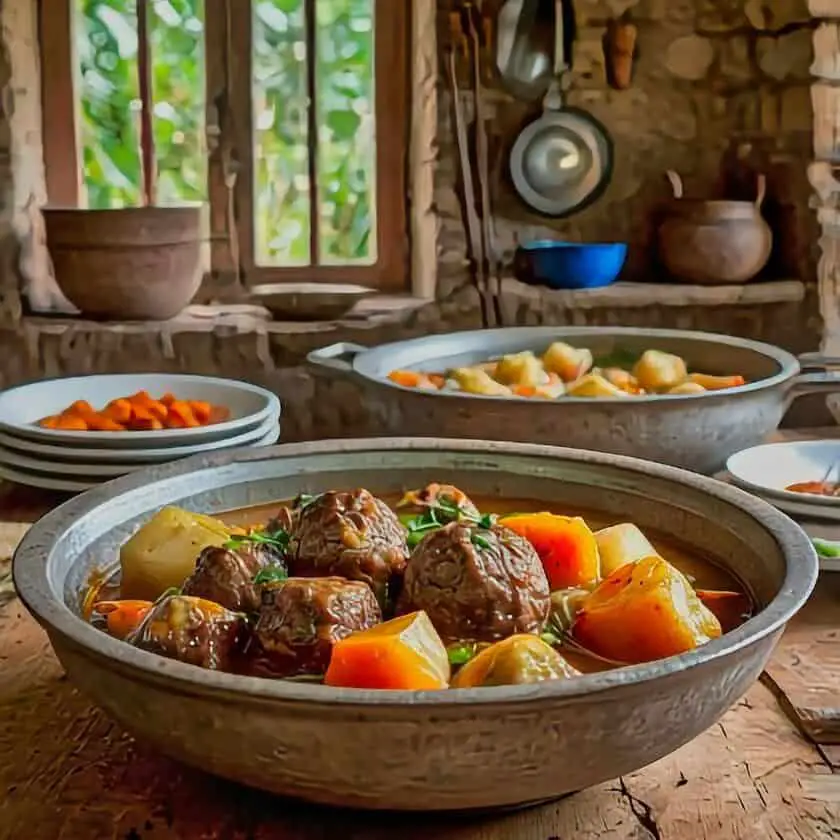The Haitian Bouyon Bef Recipe was the highlight of our food tour today – it was a great trip! This Haitian beef stew is a dish with a history of flavors. We met this local chef and learned this recipe.
The Haitian Bouyon Bef Recipe is colorful and has different textures. It uses beef chuck cubes cooked in bright broth. This broth contains big carrots, potatoes, turnip, cabbage and diced pumpkin. Observing the dish actually being prepared, you could tell every ingredient was picked for the way it tasted and how it looked in the pot.
Local chefs gave tips on how to make the Haitian Bouyon Bef Recipe. They said it is important to marinate the beef in epis, a Haitian seasoning, to make the meat taste better before cooking it. Marinate for at least a few hours or overnight if possible to make the beef tender.
Another important step was browning the beef in hot vegetable oil, which was mentioned in our tour. This keeps the flavors in and makes the broth taste deeper and richer. Use a heavy pot (cast iron is best) to hold the heat and avoid burning.
It was suggested to cut the vegetables into big pieces so they would not become too soft during long cooking. The chefs also gave one tip for making the flavor better: Whole cloves and fresh thyme may be added in the start of cooking to make the broth smell good without dominating the other products.
A fun fact about the Scotch Bonnet pepper: It’s important in Caribbean cooking and is super spicy. It was put in complete without chopping and taken out just before serving to give the bouyon a spicy flavor without being too spicy for those who like milder flavors.
Flour and water had been stirred into the boiled stew to thicken it. This prevented the stew from getting lumpy. This method creates a creamy texture that covers every piece of meat and vegetable.
It was fun learning about the Haitian Bouyon Bef Recipe and eating it too. The beef was tender, the veggies were gentle yet crunchy and also the broth was chock-full flavors from the spices and herbs it was prepared with. It was an example of how old cooking methods can make natural tastes of simple ingredients better, and make a healthy and fun meal.
Ingredients For the Haitian Bouyon Bef Recipe
Beef Chuck Cut Into 1-inch Cubes
Epis Haitian Seasoning
Vegetable Oil
Water
Chopped Large Carrots
Chopped Large Potatoes
Chopped Large Turnip
Chopped Large Onion
Minced Cloves Garlic
Chopped Small Cabbage
Diced Pumpkin
Fresh Thyme
Whole Cloves
Scotch Bonnet Pepper
Salt and pepper, to taste
All-purpose Flour
Water
Salt
Cooking Instructions For the Haitian Bouyon Bef Recipe
- In a large bowl, mix the beef cubes with the epis, ensuring all pieces are well coated. Allow the beef to marinate for at least 30 minutes to 1 hour in the refrigerator.
- In a large pot or Dutch oven, heat the vegetable oil over medium heat. Add the marinated beef and brown on all sides for about 5-7 minutes.Add the 6 cups of water to the pot, ensuring the beef is fully covered. Bring to a boil, then reduce the heat to a simmer. Cover and cook for 1 to 1.5 hours or until the beef is tender.
- While the beef is cooking, prepare the dumplings by mixing the flour, 1/2 cup water, and 1/2 teaspoon salt in a bowl. Knead the dough until smooth and form small dumplings by rolling the dough between your palms.
- When the beef is tender, add the chopped vegetables, onion, garlic, thyme, cloves, and Scotch bonnet pepper to the pot. Stir gently to combine.
- Add the dumplings to the pot, making sure they are submerged in the liquid. Cover and simmer for an additional 30-40 minutes, or until the vegetables are cooked and the dumplings are firm.
- Adjust seasoning with salt and pepper to taste. Remove the Scotch bonnet pepper and thyme sprigs before serving.
Foods Most Eaten by Haitian Locals
Haitian cuisine reflects African, French, Taino, and Spanish culinary traditions. Another staple food in Haitian households is “diri ak pwa,” or rice and beans, consisting of black, red or white beans with spices and typically meat or fish. Griot (marinated and fried pork) is a popular dish served with “banan peze,” fried plantains, and pikliz (spicy pickled vegetable slaw). This is a popular combination at gatherings and celebrations.
Another popular dish is legim, a stew of vegetables that combines spinach with chayote, eggplant along with other vegetables and is usually cooked with meat or seafood and served with rice. A comforting meal on weekends is “bouillon,” a thick soup with beef, plantains, yams and other vegetables. For breakfast, “akasan,” a warm cornmeal porridge with milk and cinnamon, is a popular breakfast option.
Street food is also a staple in Haitian cuisine, with vendors selling various snacks. Pate is a flaky pastry filled with meat, fish or vegetables that is usually eaten on the go, and fritay is a platter of fried foods that include plantains, malanga, and sometimes seafood. Soup joumou, a pumpkin soup eaten on New Year’s Day to celebrate Haitian independence, is symbolic and popular. Together these dishes reflect the diversity and richness of Haitian food culture that reflects its people’s resilience and creativity.
5 Essiential Ingredients for Haitian Food
Epis (Haitian Seasoning Base): Epis may be the main ingredient of Haitian food preparation – a vibrant blend of herbs, spices and vegetables that marinate meats and flavor stews, sauces and rice dishes. Made with garlic, scallions, bell peppers, onions, parsley, thyme and quite often Scotch bonnet peppers, epis is crucial to Haitian food. It is often made in large batches and stored for use in everyday cooking.
Scotch Bonnet Peppers: Scotch bonnet peppers are an essential ingredient in Haitian food preparation, because of their heat and fruity flavor. They are used in pikliz (a spicy pickled vegetable relish), marinades and soups. The pepper is a component of the bold flavors of Haitian food.
Plantains: A staple in Haitian cuisine, plantains are fried, boiled or mashed in various dishes. They are usually a side dish or snack. A popular dish is “Banan peze,” or twice-fried plantains, and “bouyon” may consist of plantains in a broth with meat and vegetables. Plantains provide a starchy, slightly sweet accompaniment to meals, and help temper the heat in many dishes.
Rice: Rice is a staple item in Haitian diets, often served with beans, vegetables or meats. Favorite dishes include “diri ak djon djon” (black mushroom rice) or “diri ak pwa” (rice with beans). Many traditional dishes are served on rice that absorbs the flavors of sauces and stews.
Thyme: Thyme is a common herb used in Haitian cooking, giving dishes an extremely earthy and aromatic note. It is used in epis, soups, stews, and meat marinades. Its subtle yet strong taste goes well with the strong flavors and spices of Haitian food and is an essential item in the Haitian pantry.
 FAQ For the Haitian Bouyon Bef Recipe
FAQ For the Haitian Bouyon Bef Recipe
Q: What ingredients are typically used in the Haitian Bouyon Bef recipe?
A: The Haitian Bouyon Bef recipe typically includes beef as the primary protein, along with root vegetables such as yams, potatoes, carrots, and plantains. Dumplings made from flour, known as “dombrés,” are often added to give the dish heartiness. Leafy greens like spinach or watercress, and spices such as thyme, cloves, and Scotch bonnet peppers, are key for flavor. The broth is usually made with a combination of water and beef stock, and the result is a rich, flavorful stew. The variety of ingredients in the Haitian Bouyon Bef recipe makes it a nutritious, one-pot meal.
Q: How long does it take to cook the Haitian Bouyon Bef recipe?
A: The Haitian Bouyon Bef recipe takes around 2 to 3 hours to cook, depending on the cut of beef used and how tender you prefer the meat to be. The cooking process begins by browning the beef and then simmering it in broth with vegetables and spices until everything becomes tender and flavorful. Root vegetables and dumplings may be added at different stages to prevent them from overcooking. While the Haitian Bouyon Bef recipe requires some time to develop its deep flavors, the result is a comforting and filling stew that’s well worth the wait.
Q: Can the Haitian Bouyon Bef recipe be adapted for different dietary preferences?
A: Yes, the Haitian Bouyon Bef recipe can be adapted for various dietary preferences. For those who prefer a leaner meal, you can use cuts of beef with less fat or substitute beef altogether with chicken or fish. Vegetarians can replace the meat with additional root vegetables, beans, or tofu, while still keeping the rich broth and spices intact. Coconut milk can be added for a creamy texture without using meat. The flexibility of the Haitian Bouyon Bef recipe allows you to enjoy the stew’s hearty qualities while adjusting to specific dietary needs.
Q: What makes the Haitian Bouyon Bef recipe unique compared to other beef stews?
A: The Haitian Bouyon Bef recipe stands out due to its use of bold Haitian spices and the inclusion of root vegetables and dumplings, making it more than just a traditional beef stew. The addition of Scotch bonnet peppers gives it a subtle heat, while ingredients like thyme and cloves provide depth. The dumplings, or “dombrés,” add a chewy, satisfying texture that complements the tender meat and vegetables. The Haitian Bouyon Bef recipe is not just a meal; it’s a reflection of Haitian culinary traditions, combining hearty ingredients with bold flavors to create a stew that’s rich in both taste and culture.
Q: What is the best way to store and reheat leftovers from the Haitian Bouyon Bef recipe?
A: Leftovers from the Haitian Bouyon Bef recipe can be stored in an airtight container in the refrigerator for up to 3 to 4 days. When reheating, it’s best to do so slowly on the stovetop over low heat to preserve the flavors and texture of the ingredients. You may need to add a bit of water or broth if the stew has thickened too much in the fridge. If frozen, the Haitian Bouyon Bef recipe can last for up to 2 to 3 months, but it’s recommended to thaw it in the refrigerator overnight before reheating to maintain its quality.

Haitian Bouyon Bef
Instructions
- In a large bowl, mix the beef cubes with the epis, ensuring all pieces are well coated. Allow the beef to marinate for at least 30 minutes to 1 hour in the refrigerator.
- In a large pot or Dutch oven, heat the vegetable oil over medium heat. Add the marinated beef and brown on all sides for about 5-7 minutes.
- Add the 6 cups of water to the pot, ensuring the beef is fully covered. Bring to a boil, then reduce the heat to a simmer. Cover and cook for 1 to 1.5 hours or until the beef is tender.
- While the beef is cooking, prepare the dumplings by mixing the flour, 1/2 cup water, and 1/2 teaspoon salt in a bowl. Knead the dough until smooth and form small dumplings by rolling the dough between your palms.
- When the beef is tender, add the chopped vegetables, onion, garlic, thyme, cloves, and Scotch bonnet pepper to the pot. Stir gently to combine.
- Add the dumplings to the pot, making sure they are submerged in the liquid. Cover and simmer for an additional 30-40 minutes, or until the vegetables are cooked and the dumplings are firm.
- Adjust seasoning with salt and pepper to taste. Remove the Scotch bonnet pepper and thyme sprigs before serving.



3 comments
The haitian bouyon bef recipe was very satisfying. I liked the overall taste and texture. It’s the kind of dish that made a good impression from start to finish.
I cant believe they didnt mention the secret ingredient for the best Haitian Bouyon Bef recipe – a dash of hot sauce! It takes it to a whole new level of flavor. Whos with me on this spicy twist?
I cant believe they didnt mention the secret ingredient in the Haitian Bouyon Bef recipe! Thats like leaving out the best part of the whole dish. Its a game-changer, trust me.
Comments are closed.